True Modeler's Rocket Kits Aries 'Fat Albert'
True Modeler's Rocket Kits - Aries 'Fat Albert'
Contributed by Mark Newton
| Construction Rating: | starstarstarstarstar |
| Flight Rating: | starstarstarstarstar |
| Overall Rating: | starstarstarstarstar |
| Manufacturer: | True Modeler's Rocket Kits  |
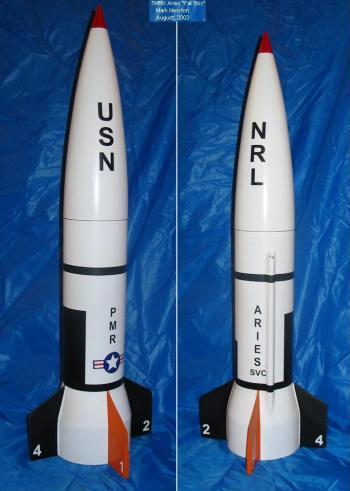
Brief:
True Modeler's Rocket Kits (TMRK) formally released their 1:14 scale Aries
"Fat Albert" in November, 2003. I was fortunate enough to purchase
one of the beta kits. The kit may seem pricey at $79.95 but once you see the
components, the cost becomes apparent.
Kit Contents:
This kit is made of quality components throughout.
- The nosecone is hard balsa and comes already weighted for flight, with the screw eye secured in epoxy. The nosecone is heavy, having about 6 oz of weight added to make the rocket stable with 4-F24 motors. The nosecone alone accounts for 1/3 of the kit's price (get the price for a 3x12 inch hard balsa cone at Balsa Machining). Another nice touch was a wrap of foam around the nosecone's tip to prevent damage in shipping.
- All small parts are in bags, and each bag has a parts list and a picture for parts identification. It doesn't get any better than this.
- The kit has heavy kraft paper body tubes
- The launch lug is long 1/4 inch ID aluminum tube.
- There is even a second copy of the paper shroud, in the event that your first try doesn't work.
- A 24 inch synthetic parachute
- The motor tubes (4) are lined with aluminum foil - another nice touch.
- All centering rings are laser-cut plywood
- The motor retention system is already installed in the aft centering ring
- Water-slide and peel-off decals
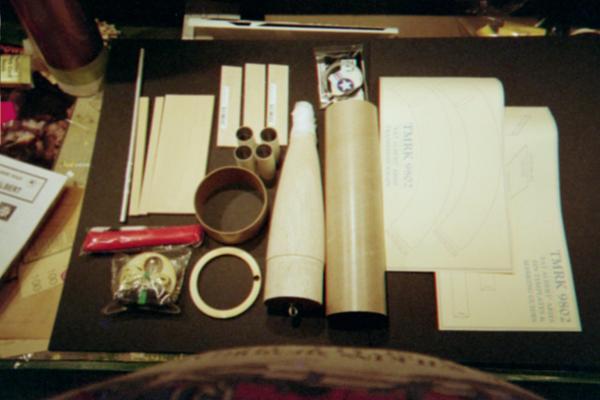
Construction:
 The
instructions are clearly written and easy to follow. This is a skill level 3 or
4 kit, primarily due to fin construction and the large shroud. Construction
requires epoxy and thin CA and the usual items (hobby knife, etc). If you have
one, I recommend a hobby saw for cutting the heavy fin stock.
The
instructions are clearly written and easy to follow. This is a skill level 3 or
4 kit, primarily due to fin construction and the large shroud. Construction
requires epoxy and thin CA and the usual items (hobby knife, etc). If you have
one, I recommend a hobby saw for cutting the heavy fin stock.
The base of the kit is a 4 inch ring tube, and is installed with 8 heavy-duty wooden spacers. I found the spacers to be about 1/4 inch too tall, requiring a good bit of sanding to get the ring to fit. However, the design is sturdy and probably necessary if you intend to use 4 F24 motors.
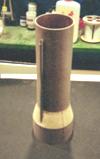
The shroud is the tricky part, since it includes a cutout for the launch lug to pass through. My first shroud was barely able to fit the large tube, and the cutout for the lug was way too small. No fear, I cut out the second one, staying outside the lines to get a larger shroud. I also used a hole punch to lengthen the launch lug cutout, and was able to get a good fit. I also changed the order of assembly on my kit: I did not install the aft centering ring until the shroud was finished. This allowed me to glue the shroud to the body from the inside, and to fill the cavity with two-part foam to reinforce the shroud. I recommend this change to anyone who wants a rock-solid shroud. If you don't have foam, stuffing the area with glue-soaked tissues would reinforce the shroud. I hardened the exterior of the shroud with thin CA, followed by light sanding to get a smooth finish.
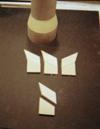
The
fins are very thick, and made with 1/4 inch wood stock. A hobby saw is great
for these cuts. A triangular piece of balsa (R/C trailing wing edge) provides
the fin's taper. The fins do require a good deal of additional tapering to
finish, but they nicely conform to the base and the shroud. A nice design.
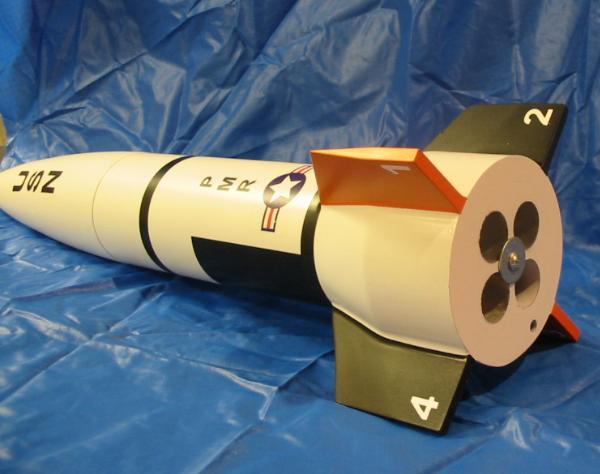
Motor retention is simple: a threaded blind-T nut sits in the middle of the motors. A bolt and fender washer retains all the motors, and can be easily replaced if necessary. Simple but effective.
Finishing:
I finished my kit by sealing the wood parts with thin CA, applying spot body to
imperfections in the balsa, followed by 3 coats of sandable primer, sanding
between each coat. I used Krylon white, orange, and black for final coats, and
then applied the decals as per the instructions.
Construction Rating: 5 out of 5
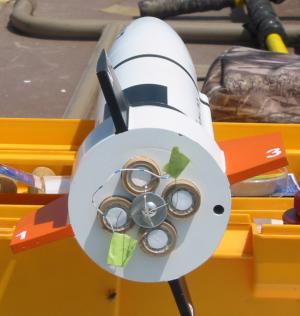
Flight:
TMRK claims that this kit can achieve almost 1/2 mile of altitude when flown
with 4 Aerotech F24 motors. That's the equivalent of an H motor, folks. For
first flights, 4 D12-5s are recommended.
My first flight was less than successful. I was at the club launch, and I was assured that the launch system could ignite a cluster of four D12-5 motors. I prepped for flight, and when the fire button was pushed, the rocket screamed about 10 feet into the air with igniter wires in tow. The rocket fell over in the grass. Two of the motors ignited. After cleaning off the mud on one fin, the rocket was prepared again, this time on a pad equipped with a relay launcher. Success! The four D12 motors gave a nice slow lift-off with about 500 ft maximum altitude. Parachute deployment was right on time, and recovery was successful. Definitely don't attempt to launch this kit without a relay launcher.
Since the first flight, I've made two more successful flights with four
D12-5 motors. This rocket never fails to get comments when I fly it. If you
want to keep it white, you'll either have to clean the aft end every time, or
paint it again. All in all, a kit that looks great and flies great, too.
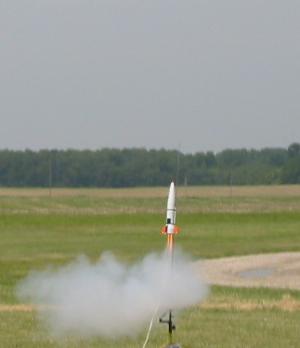
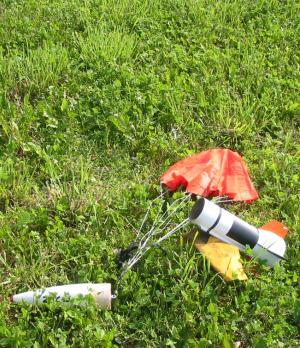
Flight Rating: 5 out of 5
Summary:
In summary, this was an enjoyable kit to build, and I was pleased with the
quality of the components and the final product. I recommend that you install
the aft ring only once the shroud is finished, providing an opportunity to
reinforce the shroud after installation. The kit may seem pricey at $80, but
its quality will not disappoint you.
Overall Rating: 5 out of 5
 |
 |